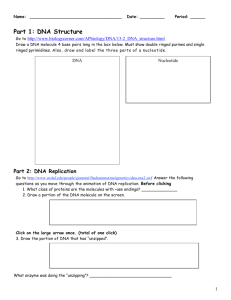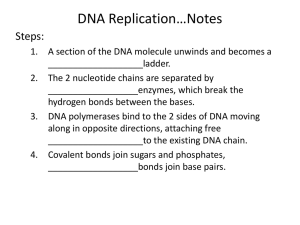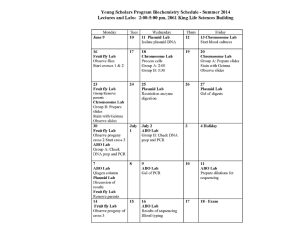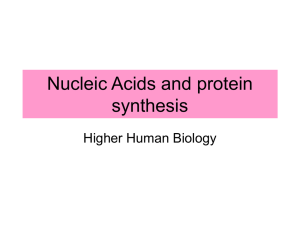Chapter 10 Vocabulary Review
advertisement
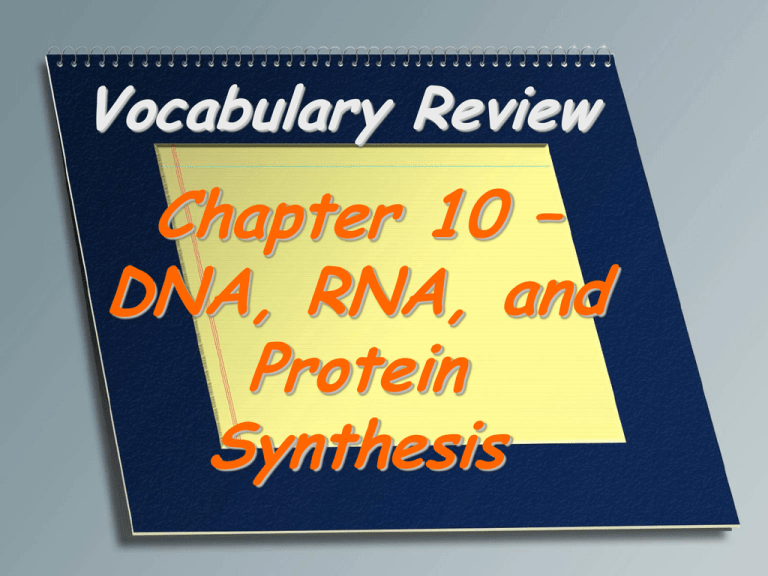
Vocabulary Review Chapter 10 – DNA, RNA, and Protein Synthesis Describes a microorganism that causes disease and that is highly infectious; refers to viruses that reproduce by the lytic cycle Virulent The transfer of genetic material in the form of DNA fragments from one cell to another or from one organism to another Transformation A virus that infects bacteria Bacteriophage In a nucleic-acid chain, a subunit that consists of a sugar, a phosphate, and a nitrogenous base Nucleotide A five-carbon sugar that is a component of DNA nucleotides Deoxyribose An organic base that contains nitrogen, such as a purine or pyrimidine; a subunit of a nucleotide in DNA and RNA Nitrogenous base A nitrogenous base that has a double-ring structure; one of the two general categories of nitrogenous bases found in DNA and RNA; either adenine or guanine Purine A nitrogenous base that has a single-ring structure; one of the two general catgories of nitrogenous bases found in DNA and RNA; thymine, cytosine, or uracil Pyrimidine The rules stating that cytosine pairs with guanine and adenine pairs with thymine in DNA, and that adenine pairs with uracil in RNA Base-pairing rules The nucleotide bases in one strand of DNA or RNA that are paired with those of another strand; adenine pairs with thymine or uracil; guanine pairs with cytosine Complementary base pair The process of making a copy of DNA DNA replication An enzyme that separates DNA strands Helicase A Y-shaped point that results when the two strands of a DNA double helix separate so that the DNA molecule can be replicated Replication fork An enzyme that catalyzes the formation of the DNA molecule DNA polymerase In each new DNA double helix, one strand is from the original molecule, and one strand is new Semiconservative replication A change in the nucleotide-base sequence of a gene or DNA molecule Mutation A natural polymer that is present in all living cells and that plays a role in protein synthesis Ribonucleic acid (RNA) The process of forming a nucleic acid by using another molecule as a template; particularly the process of synthesizing RNA by using one strand of a DNA molecule as a template Transcription The portion of protein synthesis that takes place at ribosomes and that uses the codons in mRNA molecules to specify the sequence of amino acids in polypeptide chains Translation The formation of proteins by using information contained in DNA and carried by mRNA Protein synthesis A five-carbon sugar present in RNA Ribose A single-stranded RNA molecule that encodes the information to make a protein Messenger RNA (mRNA) An RNA molecule that transfers amino acids to the growing end of a polypeptide chain during translation Transfer RNA (tRNA) An enzyme that starts the formation of RNA by using a strand of a DNA molecule as a template RNA polymerase A nucleotide sequence on a DNA molecule to which an RNA polymerase molecule binds, which initiates the transcription of a specific gene Promoter A specific sequence of nucleotides that marks the end of a gene Termination signal The rule that describes how a sequence of nucleotides, read in groups of three consecutive nucleotides that corresponds to specific amino acids, specifies the amino acid sequence of a protein Genetic code In DNA, a threenucleotide sequence that encodes an amino acid or signifies a start signal or a stop signal Codon A region of tRNA that consists of three bases complementary to the codon of mRNA Anticodon The complete genetic material contained in an individual Genome



